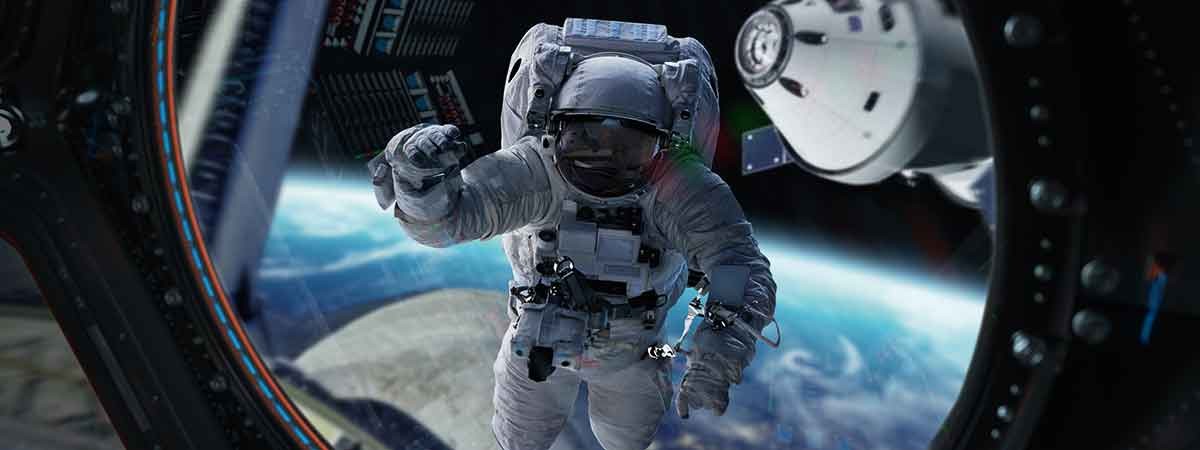Space suits act as life insurance for astronauts during extravehicular activity (EVA). The high-tech clothing is subjected to elaborate tests on Earth. An artificial vacuum simulates the extreme conditions in space during these tests.
In 1961, Yuri Gagarin was the first person in space. Today, flights into orbit and back are nearly routine; there is downright commuter traffic to the International Space Station (ISS). Before take-off, astronauts train in vacuum chambers with their special clothing for the "crossing" and for EVA.
A wearable mini-spacecraft
Astronauts can only leave the spacecraft in a space suit. Because deadly conditions prevail in space: depending on the amount of solar radiation, temperatures fluctuate between minus 200 to over 100 degrees, and people and objects are subject to bombardment from aggressive infrared, UV, x-ray and gamma radiation. Tiny micrometeorites whiz around at high speeds and become explosive projectiles on impact. Blood would boil, and lungs would burst in the non-existent atmosphere, which is close to an absolute vacuum.
The space suit prevents these things and withstands enormous stress, thanks to a sophisticated layered design. A special fabric, also used for bullet-proof vests, protects astronauts from micrometeorites. A layer of aluminium or other reflective material protects them from heating up too much in the sunlight. Several layers of high-tech fibres serve as thermal insulation, hermetically sealed and high-strength layers maintain the internal pressure and prevent the suit from swelling in vacuum. An integrated heating-cooling system ensures bearable temperatures.
Test under simulated space conditions
Some parts of the space suits are individually manufactured for each astronaut going into space. Others are assembled from finished modules and then adapted. Each future owner must then learn how to handle the special uniform and complete intensive training in space-like conditions.
The pressure levels in space are reconstructed in a vacuum chamber. There, near the earth, an ultra-high vacuum of 10-7 to 10-12 millibar prevails. Further away, there is an even higher vacuum level with less than 10-12 millibar. The pressure in the chamber, which has to be elaborately generated with extremely modern vacuum technology in several steps, approximately corresponds to the pressure at an altitude 40 kilometers above the Earth. Spending time in this vacuum atmosphere gives future astronauts a feel for how their lifesaving shell will behave under conditions with minimal pressure. But first and foremost, this is a way of checking whether the suit really holds and fulfils its vital function.

Space suit in vacuum endurance test
Space suits have to demonstrate their suitability while still on Earth
When a space suit doesn't perform
Space suits normally function reliably. But there have also been some problems. The Soviet cosmonaut Alexey Leonov was the first person to conduct extravehicular activity in space wearing a space suit in 1965. When he wanted to climb back into his spacecraft after a few minutes in space, he narrowly avoided a catastrophe. His spacesuit stiffened due to the internal pressure and became rigid. It was impossible to re-enter the narrow lock. Leonov had to first expel oxygen from his suit by using the pressure reducing valve installed for such an emergency. By doing this, he risked decompression sickness, a condition feared by divers, if he was not able to increase the pressure in the suit again fast enough. But it worked, and Leonov returned to Earth unharmed. ESA astronaut Luca Parmitano was also very lucky in 2013. Due to a clogged pump in his space suit's cooling system, water started collecting in his helmet. The Italian nearly drowned in space! However, he was able to return from the EVA to the ISS at the last minute.
Space suits normally function reliably. But there have also been some problems. The Soviet cosmonaut Alexey Leonov was the first person to conduct extravehicular activity in space wearing a space suit in 1965. When he wanted to climb back into his spacecraft after a few minutes in space, he narrowly avoided a catastrophe. His spacesuit stiffened due to the internal pressure and became rigid. It was impossible to re-enter the narrow lock. Leonov had to first expel oxygen from his suit by using the pressure reducing valve installed for such an emergency. By doing this, he risked decompression sickness, a condition feared by divers, if he was not able to increase the pressure in the suit again fast enough. But it worked, and Leonov returned to Earth unharmed. ESA astronaut Luca Parmitano was also very lucky in 2013. Due to a clogged pump in his space suit's cooling system, water started collecting in his helmet. The Italian nearly drowned in space! However, he was able to return from the EVA to the ISS at the last minute.